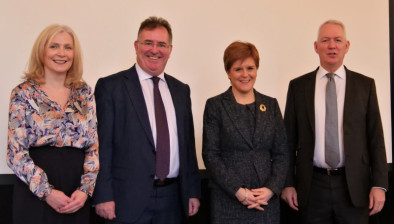CBI-Fraser of Allander index calls for action in Spring Budget

Tracy Black
Ahead of tomorrow’s Spring Budget, the annual CBI-Fraser of Allander Scottish Productivity Index is published today with a call for businesses and the Scottish and UK governments to work together to unlock investment, build sustainable growth, and to help Scottish firms achieve success globally.
The Index shows that by working together to provide the economic conditions to boost investment, firms in Scotland can tackle long standing productivity issues and deliver prosperity for both households and businesses.
The CBI-Fraser of Allander Scottish Productivity Index also highlights that helping people back into the workplace after long-term ill-health and fixing infrastructure will contribute to a successful green transition and more resilient economy of the future as Scotland seeks to deliver green growth and the pledge of 2045 net zero.
The index measures Scotland’s key productivity indicators against other parts of the UK, or international competitors, including:
- business investment
- exports
- business R&D spend
- communications technology
- skill shortage vacancies
- sickness absence and economic inactivity
The headline findings are:
- Scotland lagged in 10 of the 13 productivity indicators for which comparable data is available with the rest of the UK.
- Scotland’s percentage of economic inactivity between October 2022 and September 2023, due to long-term ill sickness, remains the highest of all the four nations at 31.7%.
- But it suggests cautious optimism for the Scottish economy as it continues to make a steady recovery from supply chain disruption caused by the COVID-19 pandemic and Brexit.
- Scotland has the highest percentage of the working-age population with higher education certificates or above (50%), surpassing the UK average (43.5%), with a strong long-term upward trend for Scotland.
The findings in detail show:
Business practices:
- Business investment as a share of Scottish GDP contracted by 0.3% in 2022 to 9.5%, underperforming the UK, which in the same period, had a 0.3% rise to 9.8%.
- The predictions are that this indicator will continue to remain below the long-term trend of 9.8%, with the UK in a similar position (10.1%)
- Exports as a share of Scottish GDP increased from 20.4% to 22.1% in 2022, compared to the UK, which rose to 3.8% on the year to 33.4%.
- While Scotland lags the UK on trade openness, both economies are showing clear signs of recovery since the pandemic slump in 2020.
- Scotland’s business R&D as a percentage of GDP has shown a marginal decrease from 1.9% in 2020 to 1.8% in 2021, while the UK remains unchanged at 2.1%.
- Although Scotland’s share of innovation-active businesses continues to rise, the pace of growth in this area is below the UK average, trailing by 5.9 percentage points in the latest research period from 2016-2018 for this particular indicator.
Skills and training:
- Scotland had the highest percentage of the working-age population with higher education certificates or above (50%), surpassing the UK average (43.5%), with an upward long-term trend since 2004, when the figure was 30.2%.
- By comparison, England’s figure is 43.2%, Northern Ireland (41.6%) and Wales (38.6%).
- There’s also optimism around job-related training. Scotland’s long and short-term figures continue to show a slight rise – from 26.4% in 2021-22 to 27.5% the following year.
Scotland is continuing to maintain its pre-pandemic level on this indicator and is second only to Wales across the UK nations.
Health and Wellbeing:
- Scotland’s percentage of economic inactivity due to long-term sickness remains the highest of all the four nations at 37.1%.
- Scotland’s rate is above the UK average of 25.8%. England’s rate (24.2%) brings down the UK average, while Wales’ (34.0%) and Northern Ireland’s (34.2%) rates bring this average up.
- Scotland’s percentage of hours lost to sickness absence rose from 2.1% to 3% in 2022, indicating a significant rise in sicknesses absence in the short-term and it remains above the pre-pandemic levels of 2% in 2019.
Infrastructure and connectivity:
- By the end of 2023, Scotland had witnessed significant increases in mean internet upload and download speeds, and since the start of 2021 - average upload speeds and download speeds are up by 308% and 247% respectively.
- Firms access to full fibre broadband have seen notable improvements and there’s been a slight improvement in 4G connectivity.
Tracy Black, CBI chief strategy officer and devolved nations and regions ambassador, said: “The Scottish Government has a renewed focus on economic growth. Discussions around our country’s potential have gone on for far too long – now is the time to take decisive action as the window narrows on Scotland’s target of achieving net zero by 2045.
“All Scotland’s sectors and regions, and the devolved and UK governments – regardless of their political differences - must work closely together for the benefit of business to achieve sustainable growth. With the Spring Budget tomorrow and a General Election looming, it is right to move beyond talking about ambitious goals and to take swift action before time runs out.
“The CBI-Fraser of Allander Productivity Index shows a decrease in business R&D spending as a percentage of Scottish GDP. Scottish firms must look at how they can embrace productivity through innovation and technology. Our shortage of skills and an ageing population means businesses have to look at other options such as new technology and innovation to make processes more efficient and improve productivity.
“Scotland has a highly educated workforce. We need to make sure they are contributing to sustainable economic growth by cultivating leadership skills, enhancing digital proficiency and integrating new technology. We must also provide chances for Scotland’s workforce to upskill and retrain for new industries as we make the switch to net zero, which will improve wages, job security and enhance productivity.”
Mairi Spowage, director at the Fraser of Allander Institute at the University of Strathclyde, which provided insights that informed the report, said: “Despite improvements in the openness of the economy over the last two years as it shrugs off the supply chain and trade jolts of COVID-19 and Brexit, the latest Index highlights that Scotland’s productivity is still lagging the rest of the UK’s performance. This is mainly down to the strength of London and the Southeast of England.
“There’s still plenty of work needed to improve workforce health with the indicators suggesting a worsening of the situation with regard to sickness absence and inactivity in the last year. This is supported by wider evidence, such as the increases in the numbers of people claiming disability-related benefits. There is an urgent need to get on top of pandemic legacy issues around long COVID and mental health, and to tackle the long waits for NHS treatment.
“A key plank of the National Strategy for Economic Transformation is on getting people back into the jobs market via investment in employability programmes. However, despite a 10-year strategy, NSET is already being reviewed and refreshed. Some of the investment needed to support people back into work has often been subject to in-year budget cuts in the last two years, which means it has not materialised.”








